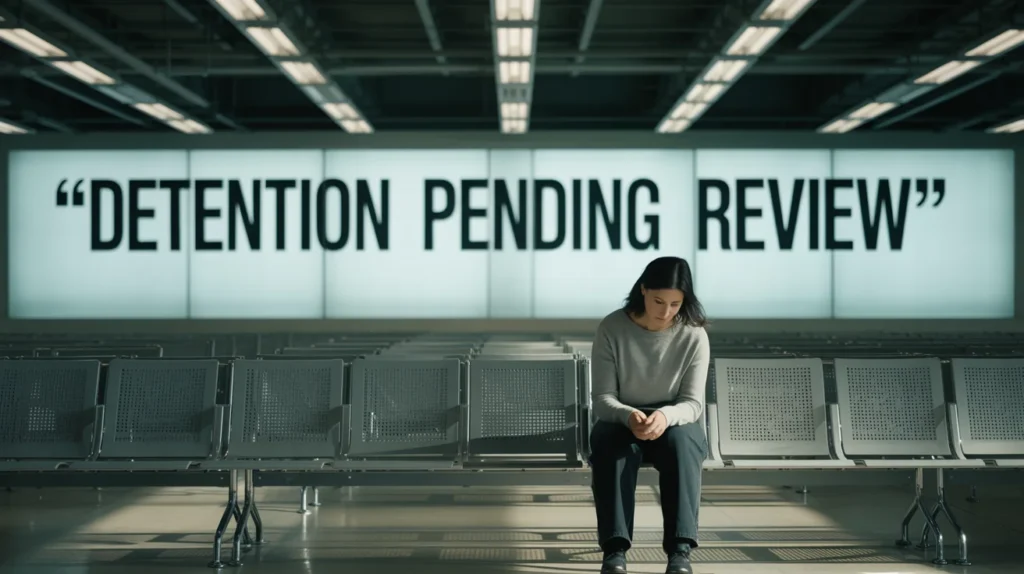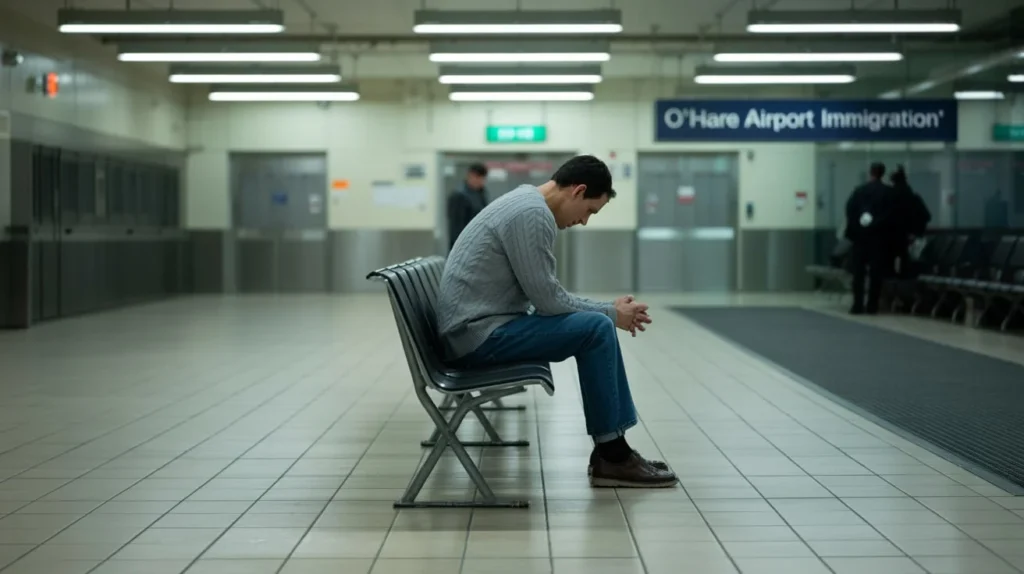Chicago O’Hare International Airport (ORD) is one of the busiest airports in the United States, handling more than 76 million passengers annually. Beyond being a global hub for travel and commerce, O’Hare also serves as a critical point of entry for thousands of immigrants, asylum seekers, and international travellers.
With this role comes the responsibility of enforcing U.S. immigration laws. However, O’Hare has increasingly been associated with immigration detention, a process that raises complex legal, humanitarian, and policy questions.
The phrase “O’Hare Airport Immigration Detention” reflects not only the enforcement of immigration rules but also the challenges faced by individuals detained by U.S. Customs and Border Protection (CBP) or Immigration and Customs Enforcement (ICE). These include travellers stopped due to visa issues, refugees seeking asylum, or foreign nationals flagged for security concerns.
Understanding immigration detention at O’Hare requires examining its history, legal frameworks, detention conditions, criticisms by advocacy groups, and broader implications for human rights.
This article explores the issue in detail, highlighting the legal, social, and humanitarian aspects of detention at O’Hare while also situating it within U.S. immigration policy as a whole.
History and Background of O’Hare’s Role in U.S. Immigration
Since its opening in 1955, O’Hare has been a primary gateway for international arrivals in the Midwest. Immigration enforcement at the airport has evolved alongside U.S. policies shaped by national security, economic migration, and humanitarian crises.
In the aftermath of the Immigration and Nationality Act of 1965, which restructured U.S. immigration quotas, airports like O’Hare became central to screening new arrivals. The terrorist attacks of September 11, 2001, transformed O’Hare into a frontline security site where immigration checks became stricter under the newly created Department of Homeland Security (DHS).
Over the decades, O’Hare has seen cases ranging from undocumented migrants seeking refuge to high-profile deportations. Its role as both a transit hub and an immigration enforcement site highlights the tension between border security and humanitarian responsibility.
Current Detention Policies and Practices at O’Hare Airport

Immigration detention at O’Hare primarily falls under the jurisdiction of CBP, a component of DHS. When international passengers arrive, they undergo inspection by CBP officers who verify travel documents, visas, and admissibility under U.S. law.
If a traveler raises legal or security concerns, they may be placed in secondary inspection, where further questioning occurs. From there, individuals may either be released, denied entry, or held in detention for transfer to ICE facilities.
Current practices at O’Hare include:
- Temporary holding in secure airport areas.
- Transfer to contracted detention centres in Illinois or neighbouring states.
- Expedited removal for individuals without valid visas.
- Referrals to asylum officers for credible fear interviews.
These policies align with federal immigration laws but are often criticized for lack of transparency and humanitarian oversight.
Immigration Procedures for International Arrivals
Every international passenger at O’Hare must pass through CBP screening. The process involves several steps:
- Document Check – Passports and visas are scanned for authenticity and validity.
- Primary Inspection – Travelers answer questions about purpose of visit, length of stay, and background.
- Secondary Inspection – If concerns arise, the traveler is referred for in-depth questioning and background checks.
- Detention or Admission – Based on findings, CBP either admits the traveler, detains them, or issues an expedited removal order.
Asylum seekers undergo a separate process. They may be detained while waiting for a credible fear interview with asylum officers. During this period, many remain in holding facilities, often without access to legal counsel or family communication.
Legal Frameworks Governing Immigration Detention
Immigration detention at O’Hare is governed by a complex web of laws and agencies:
- Department of Homeland Security (DHS): Oversees immigration enforcement and policy.
- Customs and Border Protection (CBP): Handles initial screenings and airport detentions.
- Immigration and Customs Enforcement (ICE): Manages long-term detention and deportations.
- Immigration and Nationality Act (INA): Provides the legal basis for admissions, removals, and asylum claims.
- International Human Rights Treaties: Although the U.S. has not fully adopted all provisions, agreements like the Refugee Convention influence advocacy efforts.
This framework places O’Hare within a national system of immigration enforcement but also subjects it to scrutiny when practices appear to violate constitutional rights or international norms.
Common Reasons for Detention at O’Hare
Detainees at O’Hare are typically held for several reasons:
- Visa Violations – Overstayed visas, fraudulent documents, or expired permits.
- Asylum Claims – Individuals requesting protection due to persecution in their home country.
- Security Concerns – Travellers flagged for possible links to terrorism or criminal activity.
- Undocumented Entry – Attempts to enter without valid authorization.
- Administrative Errors – Mistakes in documentation or system mismatches.
Each reason carries different legal consequences, ranging from temporary detention to long-term ICE custody.
Conditions and Facilities of Detention at O’Hare
O’Hare does not have a large-scale detention center on-site but maintains temporary holding cells within the airport. These areas are designed for short-term custody before detainees are either released or transferred.
Conditions reported at O’Hare include:
- Cold, windowless rooms sometimes referred to as “iceboxes.”
- Limited access to food, water, and restrooms.
- Restrictions on phone calls and attorney access.
- Overcrowding during peak travel times.
Advocacy groups have criticized these facilities for failing to meet international detention standards, particularly when asylum seekers or children are involved.
Humanitarian Concerns and Criticisms Raised by Advocacy Groups
Civil liberties organizations, immigrant-rights coalitions, and local legal aid providers argue that short-term holding areas at O’Hare can be excessively cold, crowded, and poorly equipped for vulnerable travelers especially children, pregnant people, and asylum seekers with medical needs.
They report inconsistent access to food, potable water, blankets, and hygiene supplies, as well as limited opportunities to contact family or counsel during critical early hours of processing. Advocates also criticize opaque decision-making by CBP and ICE, noting that detainees often receive little written information about why they are being held, what will happen next, or how to request legal assistance or language interpretation.
Concerns extend to the psychological toll of confinement, where prolonged secondary inspection and overnight holds may exacerbate trauma experienced by those fleeing persecution. Groups further contend that rapid transfers to off-site facilities complicate attorney access and impede credible fear assessments for asylum seekers. In response, they call for transparent standards, independent monitoring, guaranteed access to counsel and interpreters, trauma-informed screening, and greater use of community-based alternatives to detention.
Legal Rights of Detainees and Due Process Challenges
While U.S. law guarantees certain rights to detainees, the reality at O’Hare often falls short.
- Right to Counsel: Detainees may hire lawyers, but are not provided government-funded attorneys.
- Right to Asylum: Individuals may request asylum regardless of visa status.
- Right to Due Process: Immigration courts must review detention and removal decisions.
Challenges include rushed hearings, language barriers, and a lack of access to evidence. Advocacy lawyers argue that these conditions undermine constitutional protections.
Impact on Families, Communities, and Travellers
Immigration detention at O’Hare Airport carries consequences that extend well beyond the individuals held in custody. For families, even short-term detentions can result in painful separations, uncertainty, and emotional distress particularly when parents are prevented from communicating with children or relatives waiting outside the airport.
Communities in Chicago and across Illinois also feel the ripple effects, as news of detentions spreads fear among immigrant populations who may already be hesitant to engage with authorities or travel internationally. This sense of vulnerability can disrupt community trust, discourage lawful mobility, and contribute to social isolation. For international travelers, the experience of being detained sometimes for administrative errors or minor visa issues can tarnish perceptions of U.S. hospitality and create long-lasting anxieties about future travel.
Business travelers may face lost opportunities, while tourists can be left with a negative impression of both O’Hare and the broader U.S. immigration system. In this way, detention practices influence not only individual lives but also the city’s global reputation as a welcoming and connected hub.
Case Studies and Real-Life Incidents at O’Hare
Key Examples of Detention Incidents
- 2017 Travel Ban Detentions: During the Trump administration’s travel ban, multiple passengers from Muslim-majority countries were detained at O’Hare, prompting large-scale protests and urgent legal challenges.
- Wrongful Detentions of U.S. Citizens: Several U.S. citizens of immigrant background were mistakenly detained due to identity mismatches or database errors, sparking criticism of CBP procedures.
- Asylum Seekers Held at O’Hare: Central American migrants seeking asylum were confined for long hours in temporary holding areas with inadequate facilities before being transferred to ICE custody.
- Family Separation Cases: Families traveling together have been separated during secondary inspection, leaving children and parents in distress without clear communication.
- Rapid Legal and Community Response: Each high-profile case at O’Hare has mobilized local attorneys, NGOs, and grassroots groups to provide emergency aid and public accountability.
Comparison with Other U.S. Airports’ Detention Practices
Compared to other major airports like JFK in New York or LAX in Los Angeles, O’Hare sees a similar pattern of short-term detention followed by transfer. However:
- O’Hare’s facilities are smaller, leading to overcrowding.
- Chicago’s strong immigrant advocacy network provides more legal challenges.
- Public protests at O’Hare during the 2017 travel ban were among the largest in the nation.
This makes O’Hare both typical and uniquely significant in immigration debates.
Media Coverage and Public Perception
Media coverage of O’Hare immigration detention has shaped public opinion. Major outlets like the Chicago Tribune and national networks have reported extensively on protests, family separations, and court challenges.
Public perception often depends on political leanings: some view detention as necessary for security, while others see it as a violation of human rights. Social media has amplified both narratives, making O’Hare a focal point in national immigration debates.
Role of Lawyers, NGOs, and Immigration Advocates
Immigration lawyers and NGOs play a critical role at O’Hare. Groups such as the National Immigrant Justice Centre (NIJC) provide legal aid, while grassroots organizations offer humanitarian support.
These advocates work to:
- Secure legal representation for detainees.
- Document conditions inside holding cells.
- Challenge unlawful detentions in federal court.
- Educate travellers and immigrant communities about their rights.
Their presence at O’Hare has been essential in ensuring accountability and upholding human rights.
Government and Policy Responses to Detention Controversies
In response to public criticism, U.S. authorities have made limited reforms. For example, DHS has pledged to improve conditions in holding facilities and expand alternatives to detention, such as supervised release.
However, critics argue that these measures are insufficient, noting continued reports of mistreatment and legal violations. The Biden administration has promised more humane immigration enforcement, but O’Hare remains a site of contention between federal policy and local advocacy.
Future Outlook of Immigration Detention Policies in the U.S.
The future of immigration detention at O’Hare will depend on broader U.S. policy shifts. Possible trends include:
- Increased use of technology and electronic monitoring instead of physical detention.
- Greater emphasis on humanitarian protections for asylum seekers.
- Continued legal battles over due process rights.
- Rising tensions as global migration pressures increase arrivals.
O’Hare’s experience will likely mirror national debates, serving as both a practical enforcement site and a symbolic battleground over immigration policy.
Conclusion
O’Hare Airport immigration detention represents the intersection of law enforcement, national security, and human rights. While the airport functions as a critical gateway to the United States, its role in detaining immigrants and asylum seekers exposes systemic challenges in U.S. immigration policy.
From visa violations to asylum claims, the reasons for detention are diverse, but the consequences are often severe family separation, prolonged detention, and restricted access to legal protections. Advocacy groups continue to highlight humanitarian concerns, while government agencies stress the need for security and law enforcement.
As immigration remains one of the most divisive issues in American politics, O’Hare Airport stands as a microcosm of the national debate. Addressing these challenges will require not only legal reforms but also a renewed commitment to balancing border control with compassion, due process, and respect for human dignity.

